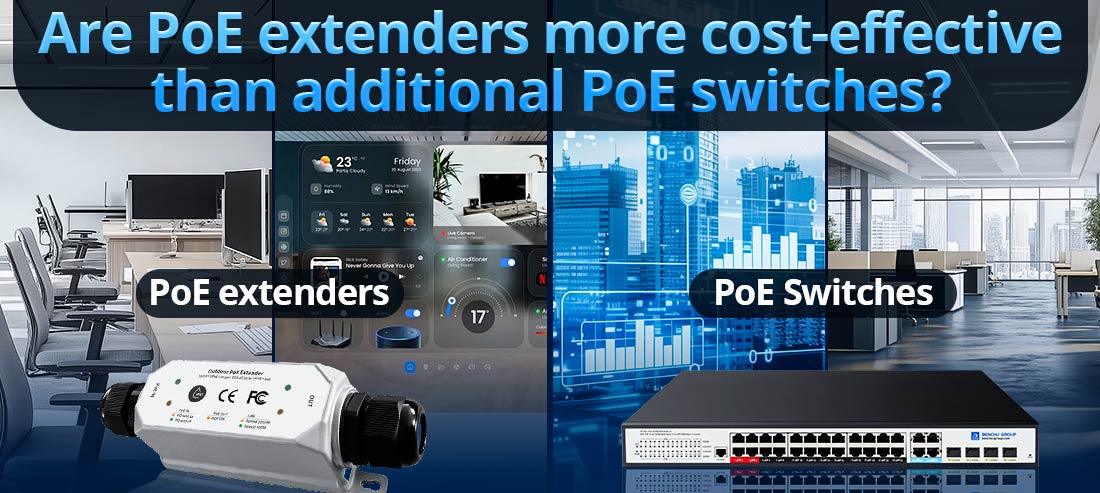
Se os extensores PoE (Power over Ethernet) são mais econômicos do que os switches PoE adicionais depende de vários fatores, incluindo os requisitos da rede, o orçamento de energia, a complexidade da instalação e a escalabilidade geral. Abaixo está uma comparação detalhada de extensores PoE e switches PoE para ajudar a determinar qual opção é mais econômica para diferentes cenários:
1. Custo Inicial
Extensores PoE:
--- Normalmente custam entre US$ 20 e US$ 100 para modelos básicos a médios e até US$ 200 ou mais para dispositivos de nível industrial.
--- Eles são uma solução econômica para estender energia e dados a alguns dispositivos em distâncias mais longas sem exigir infraestrutura adicional.
--- Economia: Se você precisar conectar apenas um ou dois dispositivos em um local remoto, um extensor PoE geralmente é mais acessível do que adicionar um switch.
Interruptores PoE:
--- O custo de Interruptores PoE varia amplamente, começando em cerca de US$ 50 para modelos pequenos não gerenciados e chegando a US$ 200+ para modelos maiores, gerenciados ou de alta potência.
--- Adicionar um novo switch PoE pode ser mais caro inicialmente, especialmente se você precisar alimentar apenas um ou dois dispositivos e as portas adicionais do switch não forem utilizadas.
--- Custo-benefício: Para configurações onde vários dispositivos precisam de conectividade em um único local, um switch PoE pode oferecer melhor valor devido à sua escalabilidade.
2. Complexidade da instalação
Extensores PoE:
--- Fácil de instalar e normalmente plug-and-play, não exigindo fonte de alimentação ou configuração adicional.
--- Amplie o alcance de uma rede PoE existente sem a necessidade de cabeamento extra ou tomadas elétricas no ponto médio.
--- Custo-benefício: Reduza os custos de instalação e manutenção ao estender o alcance de um único dispositivo em uma rede existente.
Interruptores PoE:
--- Requer infraestrutura adicional, como tomadas elétricas e cabeamento de rede, para suportar o novo switch.
--- A instalação e configuração podem exigir mais tempo e conhecimento, especialmente para switches gerenciados.
--- Custo-benefício: Custos de instalação mais elevados, mas mais adequado para cenários que exigem conexões de vários dispositivos em um local central.
3. Considerações sobre distância
--- Estenda a energia e os dados além do limite Ethernet padrão de 100 metros (328 pés), geralmente até 300 metros adicionais ou mais com vários extensores.
--- Ideal para conectar dispositivos em locais remotos onde adicionar um switch seria impraticável ou caro.
--- Custo-benefício: Superior para implantações de longa distância, pois elimina a necessidade de fontes de energia intermediárias ou switches.
Interruptores PoE:
--- Limitado ao alcance Ethernet de 100 metros entre o switch e os dispositivos conectados, a menos que sejam emparelhados com outras tecnologias de extensão de alcance (por exemplo, conversores de fibra óptica ou extensores adicionais).
--- Pode exigir switches ou extensores adicionais para conectividade de longa distância.
--- Custo-benefício: Menos econômico para implantações remotas, a menos que vários dispositivos precisem de conectividade em um ponto intermediário.
4. Escalabilidade
Extensores PoE:
--- Projetado para estender a conexão para um número limitado de dispositivos (normalmente um ou dois).
--- Não escalável para grandes implantações, pois o encadeamento de vários extensores pode reduzir a eficiência energética e aumentar a latência.
--- Custo-benefício: Menos escalável e não ideal para expandir uma rede com vários dispositivos.
Interruptores PoE:
--- Fornece várias portas para conectar vários dispositivos, tornando-os inerentemente mais escaláveis.
--- Os switches PoE gerenciados também permitem gerenciamento avançado de rede, como VLANs, QoS e monitoramento remoto, o que pode agregar valor em implantações maiores.
--- Custo-benefício: Mais econômico para expandir redes onde vários dispositivos estão localizados em uma área.
5. Orçamento de energia
Extensores PoE:
--- Obtenha energia do switch ou injetor PoE principal e reinjete-a no cabo Ethernet de saída. Cada extensor em uma cadeia consome uma parte do orçamento de energia disponível, reduzindo a energia disponível para dispositivos terminais.
--- Custo-benefício: pode exigir switches PoE de alta potência (por exemplo, 802.3bt) para manter energia suficiente para todos os dispositivos, aumentando potencialmente os custos gerais.
Interruptores PoE:
--- Fornece sua própria energia aos dispositivos conectados, tornando-os mais adequados para aplicações de alta potência ou implantações com vários dispositivos.
--- Custo-benefício: Superior para aplicações de alta potência, pois mantêm uma fonte de alimentação consistente para todos os dispositivos.
6. Manutenção e Confiabilidade
Extensores PoE:
--- Dispositivos simples com requisitos mínimos de manutenção, mas menos robustos que switches para lidar com alto tráfego ou configurações de rede complexas.
--- Custo-benefício: Custos de manutenção mais baixos, mas funcionalidade limitada em comparação com switches.
Interruptores PoE:
--- Ofereça recursos avançados, capacidades de monitoramento e maior confiabilidade para redes grandes ou complexas.
--- Custo-benefício: Custos de manutenção mais elevados, mas oferecem maior confiabilidade e flexibilidade a longo prazo.
7. Casos de uso
Quando escolher extensores PoE:
--- Estendendo a rede para um único dispositivo ou alguns dispositivos em longas distâncias.
--- Situações em que adicionar tomadas elétricas ou interruptores adicionais é impraticável ou caro.
--- Aplicações que exigem mudanças mínimas de infraestrutura, como câmeras IP remotas ou pontos de acesso.
Quando escolher switches PoE:
--- Conectando vários dispositivos em um único local ou próximo a um hub central.
--- Redes que exigem escalabilidade, recursos avançados de gerenciamento ou alta potência para vários dispositivos.
--- Implantações onde a expansão a longo prazo e o controle avançado são prioridades.
Conclusão
--- Extensores PoE: Mais econômicos para implantações de pequena escala e longa distância envolvendo um ou dois dispositivos. Eles minimizam a complexidade da instalação e os custos iniciais em casos de uso específicos.
--- Switches PoE: oferecem melhor valor para implantações maiores e centralizadas, onde vários dispositivos precisam de conectividade. Eles fornecem escalabilidade, recursos avançados e fornecimento consistente de energia, o que pode compensar custos iniciais mais elevados no longo prazo.
Em última análise, a decisão depende dos requisitos específicos da rede, do orçamento e das necessidades de escalabilidade.